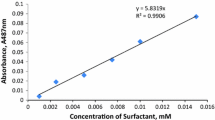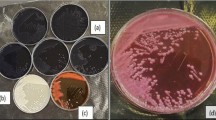Abstract
Strain CICC 23870 capable of decolorization of various azo dyes under high saline conditions was isolated from saline-alkali soil. The oxygen-insensitive azoreductase in crude extracts exhibited a wide substrate adaptively in the presence of NADH as a cofactor. The decolorization process by free cells followed first-order kinetics, with a high Methyl Orange (MO) tolerance concentration up to 100 mg l−1 estimated by Haldane model. The average decolorization rate of free cell system was 26.30 mg g−1 h−1 at initial MO concentration of 32.7 mg l−1. However, the values for the systems of immobilized cells (4 mm) in alginate, alginate and nano-TiO2, and alginate and powered activated carbon (PAC) were 6.83, 4.64, and 11.34 mg g−1 h−1, respectively. The effective diffusion factors in the tree different matrices were calculated by diffusion-based mathematic model. The diffusion step controls the overall decolorization rate, and the effective diffusion coefficients varied with internal structure of the bead matrices. The diffusion coefficients were increased from 4.98 × 10−9 to 2.25 × 10−8 cm2 s−1 when PAC was added, but decreased to 6.62 × 10−10 cm2 s−1 when nano-TiO2 was added. The immobilized matrices could be reused for at least three cycles but with a decreased decolorization rate, possibly due to the breakage of beads at the end of each cycle, which led to the loss of immobilized bacteria.





Similar content being viewed by others
References
APHA (1995) Methods for examination of water and wastewater, 19th ed. American Public Health Association/American Water Works Association/Water Environment Federation, Washington, DC, USA
Asad S, Amoozegar MA, Pourbabaee AA, Sarbolouki MN, Dastgheib SMM (2007) Decolorization of textile azo dyes by newly isolated halophilic and halotolerant bacteria. Bioresour Technol 98:2082–2088
Bafana A, Chakrabarti T, Devi SS (2008) Azoreductase and dye detoxification activities of Bacillus velezensis strain AB. Appl Microbiol Biotechnol 77:1139–1144
Borch T, Inskeep WP, Harwood JA, Gerlach R (2005) Impact of ferrihydrite and anthraquinone-2,6-disulfonate on the reductive transformation of 2,4,6-trinitrotoluene by a gram-positive fermenting bacterium. Environ Sci Technol 39:7126–7133
Chen XJ, Xu MY, Wei JB, Sun GP (2010) Two different electron transfer pathways may involve in azoreduction in Shewanella decolorationis S12. Appl Microbiol Biotechnol 86:743–751
Chen DZ, Fang JY, Shao Q, Ye JX, Ouyang DJ, Chen JM (2013) Biodegradation of tetrahydrofuran by Pseudomonas oleovorans DT4 immobilized in calcium alginate beads impregnated with activated carbon fiber: mass transfer effect and continuous treatment. Bioresour Technol 139:87–93
Dursun AY, Tepe O (2005) Internal mass transfer effect on biodegradation of phenol by Ca-alginate immobilized Ralstonia eutropha. J Hazard Mater 126:105–111
Fang H, Wenrong H, Yuezhong L (2004) Investigation of isolation and immobilization of a microbial consortium for decoloring of azo dye 4BS. Water Res 38:3596–604
Fang L, Yang S, Huang Q, Xue A, Cai P (2014) Biosorption mechanisms of Cu(II) by extracellular polymeric substances from Bacillus subtilis. Chem Geol 386:143–151
Gao Q, Zhu XH, Mu J, Zhang Y, Dong XW (2009) Using Ruditapes philippinarum conglutination mud to produce bioflocculant and its applications in wastewater treatment. Bioresour Technol 100:4996–5001
Guo J, Zhou J, Wang D, Tian C, Wang P, Uddin MS (2008) A novel moderately halophilic bacterium for decolorizing azo dye under high salt condition. Biodegradation 19:15–19
Jadhav JP, Parshetti GK, Kalme SD, Govindwar SP (2007) Decolourization of azo dye methyl red by Saccharomyces cerevisiae MTCC 463. Chemosphere 68:394–400
Jodra Y, Mijangos F (2003) Phenol adsorption in immobilized activated carbon with alginate gels. Sep Sci Technol 38:1851–1867
Kampmann M, Boll S, Kossuch J, Bielecki J, Uhl S, Kleiner B, Wichmann R (2014) Efficient immobilization of mushroom tyrosinase utilizing whole cells from Agaricus bisporus and its application for degradation of bisphenol A. Water Res 57:295–303
Khalid A, Arshad M, Crowley DE (2008) Decolorization of azo dyes by Shewanella sp. under saline conditions. Appl Microbiol Biotechnol 79:1053–1059
Khalid A, Kausar F, Arshad M, Mahmood T, Ahmed I (2012) Accelerated decolorization of reactive azo dyes under saline conditions by bacteria isolated from Arabian seawater sediment. Appl Microbiol Biotechnol 96:1599–1606
Lang W, Sirisansaneeyakul S, Ngiwsara L, Mendes S, Martins LO, Okuyama M, Kimura A (2013) Characterization of a new oxygen-insensitive azoreductase from Brevibacillus laterosporus TISTR1911: toward dye decolorization using a packed-bed metal affinity reactor. Bioresour Technol 150:298–306
Li WW, Yu HQ (2014) Insight into the roles of microbial extracellular polymer substances in metal biosorption. Bioresour Technol 160:15–23
Li GZ, Park S, Rittmann BE (2012) Developing an efficient TiO2-coated biofilm carrier for intimate coupling of photocatalysis and biodegradation. Water Res 46:6489–6496
Liu GF, Zhou JT, Meng XM, Fu SQ, Wang J, Jin RF, Lv H (2013) Decolorization of azo dyes by marine Shewanella strains under saline conditions. Appl Microbiol Biotechnol 97:4187–4197
Mahmoodi NM, Arabloo M, Abdi J (2014) Laccase immobilized manganese ferrite nanoparticle: synthesis and LSSVM intelligent modeling of decolorization. Water Res 67:216–26
Maier J, Kandelbauer A, Erlacher A, Cavaco-Paulo A, Gubitz GM (2004) A new alkali-thermostable azoreductase from Bacillus sp. strain SF. Appl Environ Microbiol 70:837–844
Massalha N, Shaviv A, Sabbah I (2010) Modeling the effect of immobilization of microorganisms on the rate of biodegradation of phenol under inhibitory conditions. Water Res 44:5252–9
Meng XM, Liu GF, Zhou JT, Fu QS (2014) Effects of redox mediators on azo dye decolorization by Shewanella algae under saline conditions. Bioresour Technol 151:63–68
Mu H, Chen Y, Xiao N (2011) Effects of metal oxide nanoparticles (TiO2, Al2O3, SiO2 and ZnO) on waste activated sludge anaerobic digestion. Bioresour Technol 102:10305–10311
Ooi T, Shibata T, Sato R, Ohno H, Kinoshita S, Thuoc TL, Taguchi S (2007) An azoreductase, aerobic NADH-dependent flavoprotein discovered from Bacillus sp.: functional expression and enzymatic characterization. Appl Microbiol Biotechnol 75:377–86
Pang R, Li MZ, Zhang CD (2015) Degradation of phenolic compounds by laccase immobilized on carbon nanomaterials: diffusional limitation investigation. Talanta 131:38–45
Rau J, Stolz A (2003) Oxygen-insensitive nitroreductases NfsA and NfsB of Escherichia coli function under anaerobic conditions as lawsone-dependent azo reductases. Appl Environ Microbiol 69:3448–3455
Saratale RG, Saratale GD, Chang JS, Govindwar SP (2011) Bacterial decolorization and degradation of azo dyes: a review. J Taiwan Inst Chem Eng 42:138–157
Seesuriyachan P, Takenaka S, Kuntiya A, Klayraung S, Murakmi S, Aoki K (2007) Metabolism of azo dyes by Lactobacillus casei TISTR 1500 and effects of various factors on decolorization. Water Res 41:985–992
Tan L, Li H, Ning SX, Xu BW (2014) Aerobic decolorization and degradation of azo dyes by suspended growing cells and immobilized cells of a newly isolated yeast Magnusiomyces ingens LH-F1. Bioresour Technol 158:321–328
Tong T, Chu Thi Thanh B, Kelly JJ, Gaillard J-F, Gray KA (2013) Cytotoxicity of commercial nano-TiO2 to Escherichia coli assessed by high-throughput screening: effects of environmental factors. Water Res 47:2352–2362
Uddin MS, Zhou J, Qu Y, Guo J, Wang P, Zhao LH (2007) Biodecolorization of azo dye acid red B under high salinity condition. B Environ Contam Tox 79:440–444
Van der Zee FP, Villaverde S (2005) Combined anaerobic-aerobic treatment of azo dyes—a short review of bioreactor studies. Water Res 39:1425–1440
Wang SG, Gong WX, Liu XW, Tian L, Yue QY, Gao BY (2007) Production of a novel bioflocculant by culture of Klebsiella mobilis using dairy wastewater. Biochem Eng J 36:81–86
Wilke CR, Chang PW (1955) Correlation of diffusion coefficients in dilute solutions. AIChE J 1:264–270
Wu KJ, Lin YH, Lo YC, Chen CY, Chen WM, Chang JS (2011) Converting glycerol into hydrogen, ethanol, and diols with a Klebsiella sp HE1 strain via anaerobic fermentation. J Taiwan Inst Chem Eng 42:20–25
Yan FF, Wu C, Cheng YY, He YR, Li WW, Yu HQ (2013) Carbon nanotubes promote Cr(VI) reduction by alginate-immobilized Shewanella oneidensis MR-1. Biochem Eng J 77:183–189
Yang C, Zhu Y, Wang J, Li Z, Su X, Niu C (2015) Hydrothermal synthesis of TiO2-WO3-bentonite composites: conventional versus ultrasonic pretreatments and their adsorption of methylene blue. Appl Clay Sci 105:243–251
Yu L, Li WW, Lam MHW, Yu HQ (2011) Adsorption and decolorization kinetics of methyl orange by anaerobic sludge. Appl Microbiol Biotechnol 90:1119–1127
Yu L, Li WW, Lam MHW, Yu HQ, Wu C (2012) Isolation and characterization of a Klebsiella oxytoca strain for simultaneous azo-dye anaerobic reduction and bio-hydrogen production. Appl Microbiol Biotechnol 95:255–262
Yu L, Zhang XY, Xie T, Hu JM, Wang S, Li WW (2015) Intracellular azo decolorization is coupled with aerobic respiration by a Klebsiella oxytoca strain. Appl Microbiol Biotechnol 99:2431–9
Yuan SJ, Sun M, Sheng GP, Li Y, Li WW, Yao RS, Yu HQ (2011) Identification of key constituents and structure of the extracellular polymeric substances excreted by Bacillus megaterium TF10 for their flocculation capacity. Environ Sci Technol 45:1152–1157
Zhou J, Xu Y, Qu Y, Tan L (2010) Decolorization of Brilliant Scarlet GR enhanced by bioaugmentation and redox mediators under high-salt conditions. Bioresour Technol 101:586–591
Acknowledgments
This research was supported by the Chinese National Natural Science Foundation (No.51308300) and the National Basic Research Program of China (973 Program, No.2012CB416904), and partially funded by the Priority Academic Program Development of Jiangsu Higher Education Institutions (PAPD), the Open Project of Jiangsu Key Laboratory of Biomass Energy and Materials (JSBEM201506), and Practice Innovation Training Program of College Student (201410298048Z). We also thank Advanced Analysis and Testing Center of Nanjing Forestry University for the SEM analysis.
Conflict of interest
We declare no conflicts of interest to this work.
Ethical approval
This article does not contain any studies with animals performed by any of the authors.
Informed consent
Informed consent was obtained from all individual participants included in the study.
Author information
Authors and Affiliations
Corresponding authors
Electronic supplementary material
Below is the link to the electronic supplementary material.
ESM 1
(PDF 609 kb)
Rights and permissions
About this article
Cite this article
Yu, L., Zhang, Xy., Tang, Qw. et al. Decolorization characteristics of a newly isolated salt-tolerant Bacillus sp. strain and its application for azo dye-containing wastewater in immobilized form. Appl Microbiol Biotechnol 99, 9277–9287 (2015). https://doi.org/10.1007/s00253-015-6798-4
Received:
Revised:
Accepted:
Published:
Issue Date:
DOI: https://doi.org/10.1007/s00253-015-6798-4




